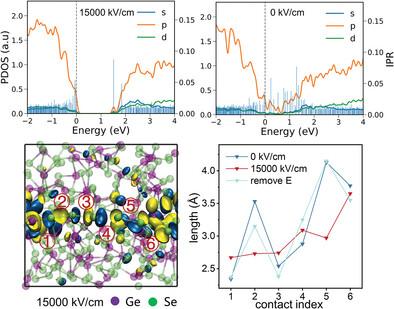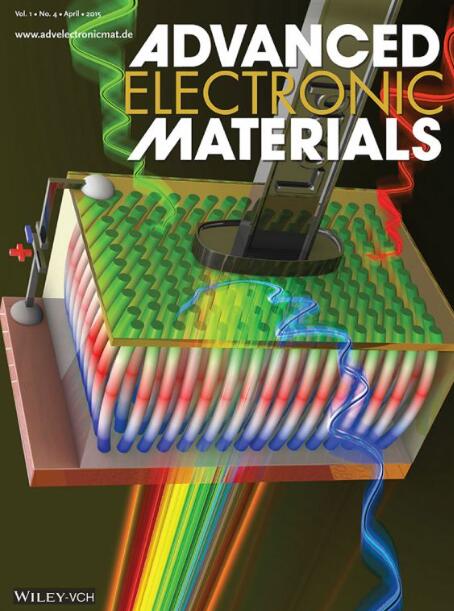Ovonic Threshold Switching Induced by Reversal of Peierls-Like Distortion in GeSe2 Glass
IF 5.3
2区 材料科学
Q2 MATERIALS SCIENCE, MULTIDISCIPLINARY
引用次数: 0
Abstract
The ovonic threshold switching (OTS) effect, observed in chalcogenide glasses (CGs), involves a reversible transition from a high-resistive state (OFF state) to a conductive state (ON state) under an electric field. However, direct observation of the dynamic process of the OTS effect is challenging, leading to debate about the mechanism of the OTS effect. In this work, the OTS effect in GeSe2 glass is studied using ab initio molecular dynamics (AIMD) with electric fields. Before applying an electric field, the glass is in the OFF state. After applying electric fields of different strength, mid-gap states appear and band tail states get wider. Atomic chains composed of Se atoms and a small number of Ge atoms, which contribute to some mid-gap states, are formed by reversal of Peierls-like distortion. These atomic chains result in chain-like molecular orbitals. The percolation of the metastable channel through a reversal of the Peierls-like distortion process on the atomic chains can be considered the cause of the transition to the ON state in GeSe2 glass. Upon removing the electric field, the glass returns to the OFF state. This study provides insight into the conduction mechanism of CGs.

通过逆转 GeSe2 玻璃中的 Peierls 类畸变诱发卵形阈值开关
在铬化玻璃(CGs)中观察到的椭圆阈值转换(OTS)效应涉及在电场作用下从高电阻状态(OFF 状态)到导电状态(ON 状态)的可逆转换。然而,直接观察 OTS 效应的动态过程具有挑战性,这导致了有关 OTS 效应机理的争论。在这项研究中,我们利用带电场的原子分子动力学(ab initio molecular dynamics,AIMD)研究了 GeSe2 玻璃中的 OTS 效应。在施加电场之前,玻璃处于关断状态。施加不同强度的电场后,中隙态出现,带尾态变宽。由 Se 原子和少量 Ge 原子组成的原子链通过佩尔斯类畸变的反向作用形成,这些原子链对某些中隙态有贡献。这些原子链形成了链状分子轨道。原子链上的 Peierls 类畸变逆转过程导致的阶跃通道渗滤可被视为 GeSe2 玻璃过渡到导通态的原因。移除电场后,玻璃恢复到关态。这项研究有助于深入了解 CG 的传导机制。
本文章由计算机程序翻译,如有差异,请以英文原文为准。
求助全文
约1分钟内获得全文
求助全文
来源期刊

Advanced Electronic Materials
NANOSCIENCE & NANOTECHNOLOGYMATERIALS SCIE-MATERIALS SCIENCE, MULTIDISCIPLINARY
CiteScore
11.00
自引率
3.20%
发文量
433
期刊介绍:
Advanced Electronic Materials is an interdisciplinary forum for peer-reviewed, high-quality, high-impact research in the fields of materials science, physics, and engineering of electronic and magnetic materials. It includes research on physics and physical properties of electronic and magnetic materials, spintronics, electronics, device physics and engineering, micro- and nano-electromechanical systems, and organic electronics, in addition to fundamental research.
 求助内容:
求助内容: 应助结果提醒方式:
应助结果提醒方式:


